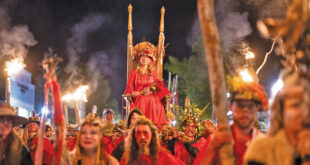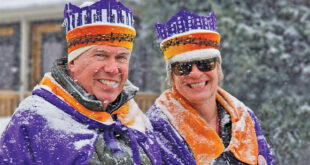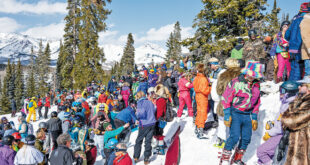When Brian Levine began bringing in his antiquarian maps, documents and photographs for archival framing, Jos Rijks of the Rijks Family Gallery couldn’t help asking about them.
Some of Levine’s favorite treasures from Colorado and Gunnison County history will be displayed and sold through the end of August.
Each has its own story, offered with the item, and Levine will share more tales during two Art Walk receptions from 5 to 8 p.m. on July 25 and August 1.
Back to the treasures: Levine loved handling the actual stock certificate signed by the famous silver mining baron Horace Tabor, or the five-foot photograph composed and printed by the great glass-plate photographer William Henry Jackson and hand-tinted by an artist whose great-grandchildren would now be elders.
Then there was the stock certificate issued to local personality Martin Verzuh for what became the Peanut Mine just outside of Crested Butte.
Those conversations between Levine, of Mt. Gothic Tomes and Reliquary, and Rijks, a fellow history buff, led to the current exhibit at the Rijks Family Gallery—An Inspiring Walk through an Illustrated History: Gunnison County, Colorado, and the American West
“How much closer to the past can you get?” Levine said. “These aren’t reproductions; they’re originals. There’s a physicality to them as opposed to abstract history.”
All of the 145 items have historical or artistic significance, like the two huge William Henry Jackson hand-tinted original photographs, one of Lake San Cristoval and the other of Marshall Pass/Mt. Ouray, probably commissioned by the Denver & Rio Grande Railroad.
There’s an 1880 claim map of the Aspen area (which was part of Gunnison County before the money flowed in and Aspenites formed their own, more affluent Pitkin County); an 1896 four-color map of the “Gunnison Gold Belt;” a 1903 photo of the Women’s Club of Crested Butte, with each member identified; original 1885 wildflower prints; and a 1914 poster announcing a Chicago White Sox training game in Florence, Colo.
Local history fans will find an 1898 issue of the Elk Mountain Pilot, a 1907 stock certificate from the Crested Butte Telephone Company, and an 1892 stock certificate from the company that built the famed Crystal Mill.
Levine also included some purely fun items in the exhibit, like movie posters for such films as the 1952 “Leadville Gunslinger” and promotions for both the Crested Butte and Aspen ski areas.
“This is different from a typical history exhibit,” Levine said. “It’s an illustrated history featuring maps, brochures, photos, stock certificates, posters, book plates, paintings and publications.”
Levine got “seduced” by historical treasure-hunting years ago while researching early Cripple Creek artifacts. The search for a specific 1900 resource book led him to an antiquarian bookstore in Denver.
Soon he was exploring old buildings in Cripple Creek, seeking out forgotten maps and documents, and talking to elders who had lived the history that fascinated him. That led to curator roles at two museums, the publication of six books on Cripple Creek and Colorado history, and a job as director of Cripple Creek’s Historic Preservation Department.
Eventually Levine’s experience led him back to another passion: rare books, such as inscribed first editions of F. Scott Fitzgerald’s Tender Is the Night and Ernest Hemingway’s To Have and Have Not. “I’m obsessed with the works of Fitzgerald. His words still speak passionately to us today,” Levine said. Levine helps institutions and individuals improve their various collections.
Levine unearths his western and literary finds in many ways—from word of mouth to unexpected encounters. Some items have been carefully tended over the years; others were accidental discoveries, like the 1914 White Sox baseball poster stuffed into walls decades ago for insulation.
Not only has Levine learned the relative value of artifacts; he’s also stumbled on some juicy tidbits of history. For example, on all the original maps and U.S. Geological Survey documents, the mountain just south of Crested Butte is identified as “Wheatstone” instead of the current “Whetstone.”
“I don’t know when or why the ‘a’ was dropped,” Levine said.
The mountain now called Avery was originally named Yank’s Peak; then one of two fortune-seeking Avery brothers staked a claim there, and it became Avery’s Peak.
The Rijks chose to host Levine’s artifacts to offer the community something unusual during the July and August Art Walks; to celebrate their family’s 20th year of gallery ownership; and to connect people with local history in a more tactile way. “I didn’t even know Crested Butte had a phone company,” Rijks said.
Check Also
Closing day celebrations
Spirits were bittersweet at the Crested Butte Mountain Resort as crowds gathered on the last …
 The Crested Butte News Serving the Gunnison Valley since 1999
The Crested Butte News Serving the Gunnison Valley since 1999




